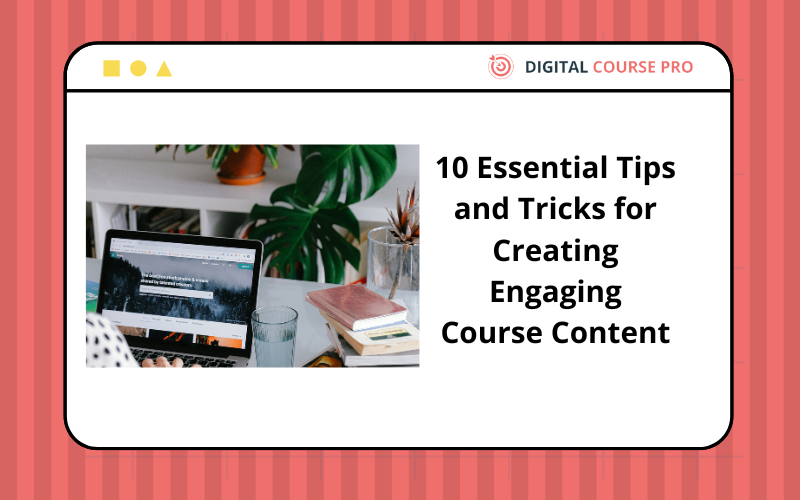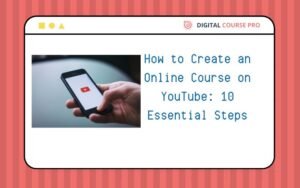Creating Engaging Course Content: Tips and Tricks is a vital topic for online course creators. Engaging content is the cornerstone of successful online learning, capturing students’ attention and motivating them to complete the course. However, creating content that keeps learners interested and invested can be challenging. In this blog post, we’ll explore ten essential tips and tricks to help you craft engaging course content that resonates with your audience.
1. Understand Your Audience
Understanding your audience is the first step in Creating Engaging Course Content: Tips and Tricks. Know who your learners are, their goals, and their pain points. Conduct surveys, interviews, and market research to gather insights into your audience’s preferences and learning styles. Tailoring your content to meet their specific needs ensures that it is relevant and engaging.
2. Set Clear Learning Objectives
Clear learning objectives provide direction and purpose for your course. Define what you want your students to achieve by the end of the course. These objectives guide the content creation process and help students understand what they will gain from the course. Clear, achievable goals keep students motivated and focused.
3. Incorporate Various Content Types
Diversity in content types is crucial for maintaining engagement. Use a mix of videos, articles, quizzes, interactive simulations, and infographics to cater to different learning styles. Each type of content can present information in unique ways, keeping the learning experience fresh and interesting.
4. Use Storytelling Techniques
Storytelling is a powerful tool in Creating Engaging Course Content: Tips and Tricks. Stories make content relatable and memorable. Incorporate real-life examples, case studies, and anecdotes to illustrate key concepts. Storytelling helps to humanize your content and makes complex information easier to understand and retain.
5. Make Content Interactive
Interactive content actively involves students in the learning process. Include activities like quizzes, polls, discussions, and interactive videos to encourage participation. Interactive elements not only make learning fun but also reinforce understanding and retention of the material.
6. Focus on Visual Appeal
Visually appealing content captures attention and enhances comprehension. Use high-quality images, videos, and graphics to break up text and illustrate key points. Ensure that your visual elements are relevant and add value to the content. Consistent branding and design also contribute to a professional and cohesive look.
7. Provide Regular Feedback
Timely feedback helps students understand their progress and areas for improvement. Incorporate regular assessments and provide constructive feedback on their performance. Feedback can be automated through quizzes or personalized in discussion forums and assignments.
8. Encourage Collaboration
Collaboration fosters a sense of community and enhances learning. Encourage group projects, peer reviews, and discussions to allow students to learn from each other. Collaborative activities make learning more dynamic and engaging, and help build a supportive learning environment.
9. Keep Content Up-to-Date
Ensure your content is current and relevant. Regularly update your course material to reflect the latest trends, research, and information. Outdated content can disengage students and undermine the credibility of your course.
10. Incorporate Real-World Applications
Linking content to real-world applications makes it more relevant and engaging. Show how theoretical concepts apply in practical scenarios. This approach helps students see the value of what they are learning and motivates them to apply their knowledge.
Conclusion
Creating Engaging Course Content: Tips and Tricks is essential for any course creator aiming to deliver a compelling learning experience. By understanding your audience and setting clear learning objectives, you lay a solid foundation for engagement. Incorporating various content types and using storytelling techniques can make your material more relatable and memorable.
Interactive elements and visual appeal are critical in keeping students interested and involved. Regular feedback and opportunities for collaboration enhance the learning experience and build a sense of community. Keeping your content up-to-date ensures that it remains relevant, and linking it to real-world applications helps students understand its practical value.
In conclusion, Creating Engaging Course Content: Tips and Tricks involves a blend of creativity, understanding, and continuous improvement. Engaging content not only captures students’ attention but also facilitates deeper learning and retention. By implementing these strategies, you can create dynamic and compelling courses that resonate with your audience and drive their success.
Remember, the key to Creating Engaging Course Content: Tips and Tricks is to keep the learner at the center of your design process. Continuously seek feedback, analyze student performance, and be willing to adapt your content to better meet their needs. This commitment to excellence will help you build courses that are not only informative but also inspiring and transformative.
If you’re looking to transform your online course business into a highly profitable venture, make sure to read our detailed guide on How to Make $10,000 a Month with an Online Course Business. This blog post is packed with actionable strategies, expert advice, and practical tips designed to help you turn your passion into a successful income stream. Whether you’re just starting out or aiming to grow your existing courses, our guide provides all the tools and insights you need to achieve your financial goals. Visit our blog today and start your journey towards making $10,000 a month!





